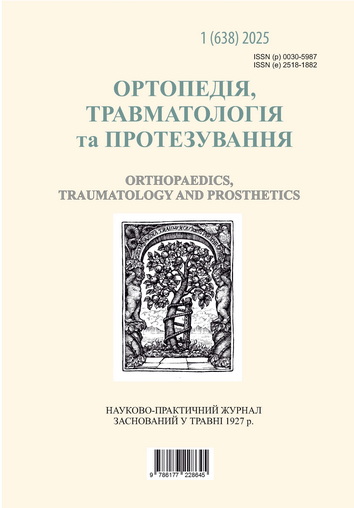QUALITY CRITERIA FOR MINIMALLY MANIPULATED BIOTECHNOLOGICAL PRODUCTS BASED ON AUTOLOGOUS BONE MARROW ASPIRATE FOR USE IN TRAUMATOLOGY AND ORTHOPEDICS
DOI:
https://doi.org/10.15674/0030-59872025156-64Keywords:
Regenerative orthopedics, regenerative injection therapy, osteoarthritis, avascular necrosis, hip, kneeAbstract
Autologous biotechnological products based on bone marrow (BM) are a source of stem cells, in particular, hematopoietic and multipotent mesenchymal stromal cells, and act as one of the alternative therapeutic agents that can slow cartilage degeneration, improve its repair and, ultimately, prevent joint replacement. Objective. To develop quality and safety criteria of minimally manipulated biotechnological products from autologous bone marrow for use in patients with pathology of the musculoskeletal system. Methods. The material for the development of quality and safety criteria for the manufacture and use of biotechnological products from autologous red bone marrow aspirate was 85 patients with osteoarthritis and aseptic necrosis of the hip and knee joints, who used biotechnological products made from it. Cell counts in the myelogram and CFU-analysis of MMSCBM were performed in all patients. Results. As a result of the development of quality and safety criteria for biotechnological products from BM aspirate, 3 types of it were established: 1 — polymorphic (with the presence of progenitor cells of all types within the normal range), 2 — moderately cellular (with the presence of all types of progenitor cells, but some of them below the norm), 3 — hypocellular (with the presence of most types of progenitor cells, some of them below the norm). Functional quality criteria of biotechnological products from BM aspirate were developed on the basis of CFU-analysis and calculation of seeding efficiency coefficient (KEP) of MMSK-BM. Conclusions. Quality and safety criteria of biotechnological products based on autologous bone marrow aspirate based on the results of myelograms and CFU analysis have been established. According to the results of myelograms, type 1 BM aspirate was evaluated as excellent for the further manufacture of a biotechnological product, type 2 — good, type 3 — satisfactory. According to the results of the KUOf analysis, the KEP indicator ˂ 0.001 % was evaluated as unsatisfactory, the KEP indicator within the range of 0.001–0.003 % — satisfactory, the KEP indicator ˃ 0.003 % — good. The KEP ˂ 0.001 % — unsuitable for use.
Downloads
How to Cite
Issue
Section
License
Copyright (c) 2025 Sergiy Strafun, Yevhen Holiuk, Dmytro Zubov, Oleksandr Magomedov, Halyna Starodub, Hrystyna Malova

This work is licensed under a Creative Commons Attribution 4.0 International License.
The authors retain the right of authorship of their manuscript and pass the journal the right of the first publication of this article, which automatically become available from the date of publication under the terms of Creative Commons Attribution License, which allows others to freely distribute the published manuscript with mandatory linking to authors of the original research and the first publication of this one in this journal.
Authors have the right to enter into a separate supplemental agreement on the additional non-exclusive distribution of manuscript in the form in which it was published by the journal (i.e. to put work in electronic storage of an institution or publish as a part of the book) while maintaining the reference to the first publication of the manuscript in this journal.
The editorial policy of the journal allows authors and encourages manuscript accommodation online (i.e. in storage of an institution or on the personal websites) as before submission of the manuscript to the editorial office, and during its editorial processing because it contributes to productive scientific discussion and positively affects the efficiency and dynamics of the published manuscript citation (see The Effect of Open Access).














